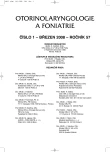Defensins – an Important Component of Natural Immunity in Defense against Infection
Authors:
Z. Kuchynková 1; H. Pácová 1,2
Authors‘ workplace:
Klinika otorinolaryngologie a chirurgie hlavy a krku 1. LF UK a FN Motol
Katedra otolaryngologie IPVZ, Praha
; přednosta prof. MUDr. J. Betka, DrSc.
Ústav pro histologii a embryologii, 1. LF UK, Praha
1; přednosta doc. MUDr. P. Hach, DrSc.
2
Published in:
Otorinolaryngol Foniatr, 57, 2008, No. 1, pp. 36-39.
Category:
Comprehensive Reports
Overview
Defensins are antimicrobial and immunomodulation peptides, which are the important part of natural immunity. The authors briefly characterize natural immunity, chemical structure and function of defensins. The review deals preferentially with human defensins on respiratory mucous membranes and their effects on bacteria, mainly on gram-negative Staphylococcus aureus.
Defensins exert a direct destructive effect on bacterial wall, but they possess an immunomodulation effect as well. Human defensins are divided according to their structure to alpha, beta 1, beta 2, beta 3 and beta 4. Alpha defensins are in granulocytes, in mucosa of urogenital and intestinal tract. Beta defensins are in all epithelial tissues. In the epithelium of respiratory pathways beta defensins 1 are produced constitutively and beta defensins 2 and 3 are induced as a response to infection agents.
Some bacteria can modify their wall and thereby become less sensitive to defensins. In the bacteria Staphylococcus aureus the genes Dlt and Mrpf were found responsible for modification of teichoic acid and phosphatidylglycerol in the membrane in such a way that it decreases attractiveness of the bacteria for the positively charged defensins. Defects in these genes caused increased sensitivity of this bacterium to defensins.
New knowledge of antibacterial peptides helps us to understand better infectious diseases and offers new perspectives in the therapy of these diseases.
Key words:
defensins, respiratory tract, Staphylococcus aureus.
Sources
1. Beder, M. N., Diamid, G, Verghese, M. W., Randell, S. H.: CD14-dependent lipopolysaccharide-induced beta-defensin-2 expression in human tracheobronchial epithelium. J. Biol. Chem., 275, 2000, s. 29731-29736.
2. Boman, H. G.: Antibacterial peptides: basic facts and emerging concepts. Journal of Internal Medicine, 254, 2003, s. 197-215.
3. Bowdish, D. M., Davidson, D. J., Hancock, R. E.: Immunomodulatory properties of defensins and cathelicidins. Curr Top Microbiol. Immunol., 306, 2006, s. 27-66.
4. Collins, L. V., Kristian, S. A., Weidenmaier, C., Faigle, M., Van Kessel, K. P., Van Strijp, J. A., Götz, F., Neumeister, B., Peschel, A.: Staphylococcus aureus strains lacking D-alanine modifications of teichoic acids are highly susceptible to human neutrophil killing and are virulence attenuated in mice. J. Infect. Dis.,186, 2002, s. 214-219.
5. Dorschner, R. A., Lopez-Garcia, B., Peschel, A., Kraus, D., Morikawa, K., Nizet, V., Gallo, R. L.: The mammalian ionic environment dictates microbial susceptibility to antimicrobial defense peptides. FASEB J., 20, 2006, 1, s. 35-42.
6. Hancock, R. E., Sahl, H. G.: Antimicrobial and host-defense peptides as new antiinfective therapeutic strategies. Nature Biotechnology, 24, 2006, s. 1551-1557.
7. Hertz, C. J., Wu, Q., Porter, E. M., Zhang, Y. J., Weismüller, K. H., Godowski, P. J., Ganz, T., Randell, S. H., Modlin, R. L.: Activation of Toll-like receptor 2 on human tracheobronchial epithelial cells induces the antimicrobial peptide human beta defensin-2. J. Immunol., 171, 2003, 12, s. 6820-6826.
8. Laube, D. M., Yim, S., Ryan, L. K., Kisich, K. O., Diamond, G.: Antimicrobial peptides in the airway. Curr Top Microbiol. Immunol., 306, 2006, s. 153-182.
9. Lomize, A. L., Lomize, M., Pogozheva, I. P.: Orientations of proteins in membrane, [online databáze]. University of Michigan, copyright 2005-2007, [cit.2007-09-25]. Dostupný na: <http://opm.phar.umich.edu/protein.php?pdbid=1bnb>
10. MacRedmond, R, Greene, C., Taggart, C. C., McElvaney, N., O‘Neill, S.: Respiratory epithelial cells require Toll-like receptor 4 for induction of human beta-defensin 2 by lipopolysaccharide. Respir. Res., 12, 2005, s. 116.
11. Murzin, A. G., Brenner, S., Hubbard, T., Chothia, C.: Structural classification of proteins. J. Mol. Biol., 247, 1995, s. 536-540.
12. Peschel, A.: How do bacteria resist human antimicrobial peptides? Trends Microbiol, 10, 2002, s. 179-186.
13. Staubitz, P., Neumann, H., Schneider, T., Wiedemann, I., Peschel, A.: MprF-mediated biosynthesis of lysylphosphatidylglycerol, an important determinant in staphylococcal defensin resistence. FEMS Microbiol. Lett, 231, 2004, 1, s. 67-71.
Labels
Audiology Paediatric ENT ENT (Otorhinolaryngology)Article was published in
Otorhinolaryngology and Phoniatrics

2008 Issue 1
Most read in this issue
- Evaluation of Hearing and Speech Treatment by Means of Phonological Awareness Test and Dichotic Tests
- Defensins – an Important Component of Natural Immunity in Defense against Infection
- Evaluation of Dysphagia, Treatment Possibilities of the Patient with Dysphagia at the ENT Departments in the Czech and Slovak Republics
- Cleft Defects and Their Role in the Origin of Chronic Otitis in Older Children and Adolescents
